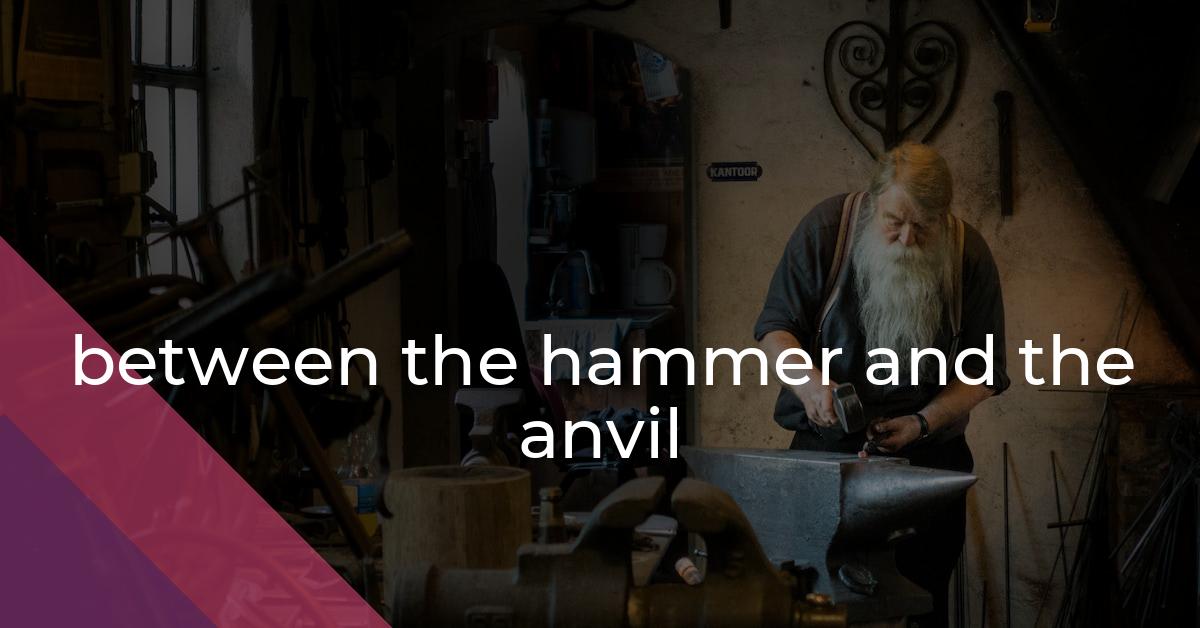between the hammer and the anvil: Idiom Meaning and Origin
What does ‘between the hammer and the anvil’ mean?
An analysis of the idiom "between the hammer and the anvil":
The idiom "between the hammer and the anvil" means being caught in a difficult or uncomfortable situation with no escape. It refers to being trapped between two opposing forces or pressures, much like being crushed between two hard objects.

Idiom Explorer
The idiom "in the thick of it" means being deeply involved or immersed in a difficult or challenging situation.
The idiom "in the hot seat" means to be in a difficult or uncomfortable position, often under scrutiny or facing intense questioning.
The idiom "in a bind" means to be in a difficult or challenging situation where there are not many options or solutions available.
Idiom Analysis:
The idiom "in a bake" means to be in a difficult or challenging situation, like being caught in a sticky situation. It implies feeling trapped or overwhelmed by circumstances.
The idiom "hit a snag" means encountering an unexpected problem or obstacle that hinders progress or causes a delay. It is often used to describe a situation where a plan or process does not go as smoothly as expected.
The idiom "hang in the balance" means to be in a state of uncertainty or indecision, where the outcome is yet to be determined.
The idiom "hammer home" means to emphasize or reinforce a point or message, usually by repeating it continuously or forcefully. It is often used to ensure that an idea or concept is clearly understood and remembered by the audience.
The idiom "hammer-headed" refers to someone who is stubborn or obstinate, often refusing to listen to reason or change their mind.
The idiom "hammer and tongs" means to do something with great energy, enthusiasm, or intensity.
Fiery Forge Plight
The idiom "between the hammer and the anvil" has its origins in Ancient Rome, specifically in the work of the Roman poet Ovid. Ovid used the phrase "malleus iniqui" which translates to "unjust hammer." This concept of being caught between two opposing forces is the core meaning behind the idiom.
The idiom gained popularity and entered the English language during the Middle Ages. In this context, the "hammer" represents a force of threat or danger, while the "anvil" symbolizes a situation that is unyielding or unwavering. The idiom suggests being caught in a difficult position, where one is faced with two undesirable options or being subjected to pressure from conflicting sources.
Its usage is not limited to a specific region or culture, as it has been adopted into various languages across the globe. The idiom portrays a universal experience of feeling trapped or having limited choices in a challenging situation.
In modern usage, "between the hammer and the anvil" is often used figuratively to describe being caught in the middle of a conflict or facing opposition from multiple sides. It conveys a sense of vulnerability, helplessness, and the need to make a difficult decision.
One example of its usage can be found in political discussions. Individuals or groups may find themselves torn between competing ideologies, pressure from different interest groups, or conflicting responsibilities. The idiom encapsulates the struggle and tension of navigating conflicting forces and making a choice that may have consequences.
Furthermore, the idiom can be employed in personal relationships. It describes situations where an individual feels torn between loyalty to different people or being caught in the middle of a disagreement between loved ones. It expresses the emotional strain of being torn between two opposing sides, creating an internal conflict that can be emotionally distressing.
Another related idiom that shares a similar meaning is "between a rock and a hard place." This expression also describes a situation where one is faced with two difficult choices or options, with no easy way out. It conveys a feeling of being trapped or squeezed between two unfavorable outcomes.
Similarly, the idiom "hammer and tongs" shares a connection to "between the hammer and the anvil." The phrase "hammer and tongs" is used to describe an intense or vigorous effort. It implies a sense of exertion or forceful action, which can contribute to the feeling of being caught between opposing forces. These idioms collectively emphasize the struggle and tension associated with making difficult choices or navigating challenging situations.
Lastly, the idiom "between the devil and the deep blue sea" bears resemblance to "between the hammer and the anvil." This expression denotes a situation in which one is faced with two equally undesirable options. The devil represents a menacing or dangerous choice, while the deep blue sea signifies a perilous or treacherous alternative. Like "between the hammer and the anvil," this idiom conveys a sense of being trapped or caught between conflicting forces.
Overall, the idiom "between the hammer and the anvil" reflects a timeless human experience. It captures the universal tension of being caught in a difficult situation, facing pressure from opposing forces, and being forced to make choices with significant consequences. These related idioms, such as "between a rock and a hard place," "hammer and tongs," and "between the devil and the deep blue sea," enhance our understanding of the complexities and challenges inherent in navigating such circumstances.
Example usage
Examples of how the idiom "between the hammer and the anvil" can be used in a sentence:
- He felt trapped between the hammer and the anvil when his boss asked him to lie to cover up their mistake.
- The politician found himself between the hammer and the anvil as he tried to satisfy both his party and the opposing voters.
- She was caught between the hammer and the anvil when she had to choose between two equally difficult options.
More "Dilemma" idioms



